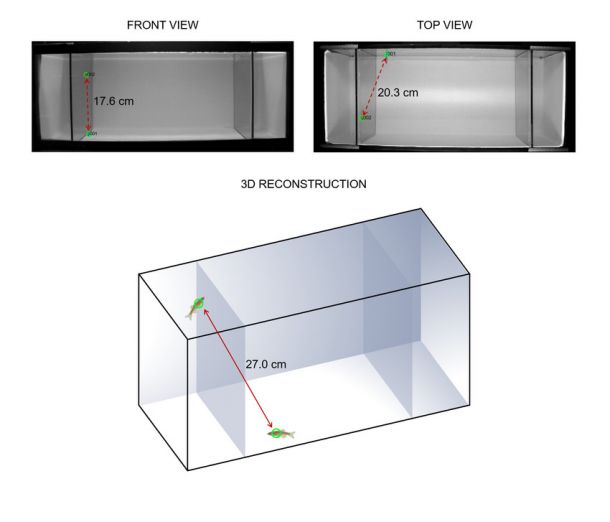3D Models Reveal Hidden Details of Zebrafish Behavior

A research team headed by Professor Maurizio Porfiri successfully developed the first successful 3D computer modeling of the motions of zebrafish, which are increasingly the species of choice for biomedical research
BROOKLYN, New York — Zebrafish have become increasingly popular model animals in preclinical and neurobehavioral research due to their genetic similarity to humans and rapid rate of reproduction. Studies of zebrafish behavior have shed light on social and biological phenomena ranging from the dynamics of collective animal behavior, such as shoaling and schooling, to anxiety, fear, and leadership. Borrowing from decades of work on mice and rats, most observations of zebrafish are conducted using a two-dimensional approach, despite the fact that zebrafish swim in three-dimensional (3D) space.
In a new paper published in Scientific Reports, a research team led by Maurizio Porfiri, professor of mechanical and aerospace engineering at the New York University Tandon School of Engineering, compared 2D and 3D observational data in a series of behavioral experiments. Their results highlighted potential compromises in data integrity in 2D-scored behaviors versus 3D, with the former tending to under-estimate locomotion in zebrafish. Because interpretation of zebrafish behavior is entirely dependent on assessment of swimming patterns and preference in response to various stimuli, such reporting errors can influence experimental outcomes.
Experiments also confirmed that 3D approaches to analyze zebrafish behavior require less than half of the number of zebrafish used in 2D approaches, with no compromise in validity. These findings may lead to a reduction in the number experimental animals.

In the first experiments of their kind, NYU Tandon researchers and their colleagues found significant discrepancies in data generated when tracking the social behavior of zebrafish in two dimensions as opposed to 3D.
The paper was co-authored by Simone Macrì of the Istituto Superiore di Sanità in Rome, Italy; Daniele Neri, Tommaso Ruberto, and Violet Mwaffo, all at NYU Tandon in Porfiri’s group; and Sachit Butail, an assistant professor of mechanical engineering at Northern Illinois University.
“Zebrafish are inherently social species who demonstrate a rich repertoire of swimming behaviors in response to various stimuli,” said Porfiri. “Two-dimensional scoring intrinsically misses a major dimension of swimming behaviors, leading to undesired false positives and false negatives. This is the first study to systematically quantify the degree to which data integrity may be compromised by this approach.”
Using data from previous zebrafish studies based on a 3D tracking software developed by Porfiri’s group, the research team compared zebrafish behavior in response to stimuli including a live conspecific and live predator, 3D-printed models of a conspecific and a predator, and a computer animated image of a predator. These experimental paradigms are commonly used to study anxiety, memory, fear, and general locomotion in zebrafish.
Their results confirmed that 2D tracking significantly underestimates zebrafish swimming behavior with respect to average speed, average peak speed, wall following, and other parameters. Additionally, 2D tracking consistently overestimated spatial preference for stimuli, an important parameter for understanding fear, anxiety, and other social behaviors. For example, zebrafish have an innate aversion towards threatening stimuli; such aversion, clearly identifiable through the 3D approach, can be overlooked when data are scored in 2D.
The researchers acknowledge that material costs and the burdens of analyzing 3D data increased computational loads, which likely prohibit the replacement of 2D approaches, but emphasize that 3D tracking systems may be a valuable complement to zebrafish behavior analysis, particularly as a means to gain rich data sets with fewer numbers of experimental subjects.
Note: Images available at http://dam.engineering.nyu.edu/?c=1952&k=97112efb75
About the New York University Tandon School of Engineering
The NYU Tandon School of Engineering dates to 1854, the founding date for both the New York University School of Civil Engineering and Architecture and the Brooklyn Collegiate and Polytechnic Institute (widely known as Brooklyn Poly). A January 2014 merger created a comprehensive school of education and research in engineering and applied sciences, rooted in a tradition of invention and entrepreneurship and dedicated to furthering technology in service to society. In addition to its main location in Brooklyn, NYU Tandon collaborates with other schools within NYU, the country’s largest private research university, and is closely connected to engineering programs at NYU Abu Dhabi and NYU Shanghai. It operates Future Labs focused on start-up businesses in downtown Manhattan and Brooklyn and an award-winning online graduate program.




